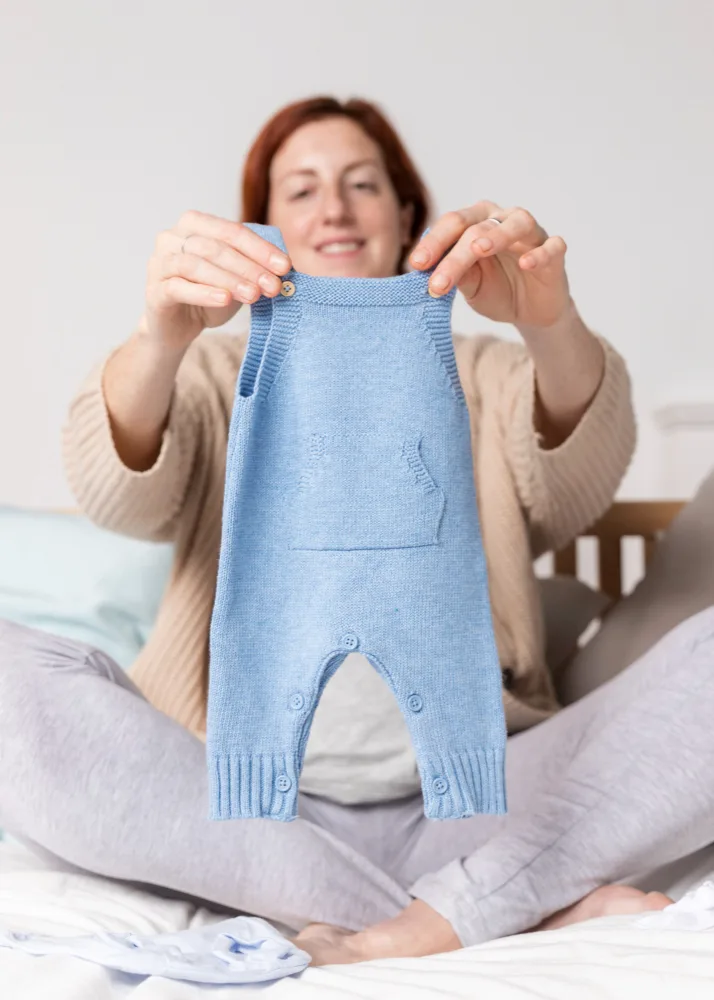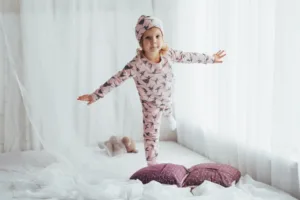I. Introduction
Dressing a baby for sleep is a crucial aspect of their overall comfort and safety. As parents and caregivers, it’s essential to understand the unique needs of infants and how to create a sleep-conducive environment. One often overlooked aspect of this is the type of clothing babies wear to bed. In this article, we’ll explore the importance of comfortable and safe sleep clothing for babies, and provide guidance on how to make informed choices for your little one.

II. Understanding Infant Sleep Needs
Infants have unique sleep needs that are distinct from those of adults. Understanding these needs is crucial for creating a sleep-conducive environment that promotes comfort and safety.
Infant Sleep Patterns
Newborns (0-3 months) sleep for 16-20 hours a day, with frequent wakings for feeding and changing. As they grow, their sleep patterns change, with most babies sleeping for 12-15 hours a day by 6 months. Infants also have different stages of sleep, including REM (rapid eye movement) and non-REM sleep, which affect their sleep quality and duration.
Factors Influencing Comfortable Sleep
Several factors influence comfortable sleep for babies, including:
- Temperature: A comfortable room temperature (between 68-72°F) and a stable body temperature are essential for sleep.
- Comfort: Soft, breathable fabrics and a comfortable sleeping position promote relaxation.
- Security: A sense of security and familiarity, such as the presence of a caregiver or a familiar object, can promote sleep.
- Darkness and Quiet: A dark, quiet environment helps regulate an infant’s circadian rhythms.
The Role of Sleep Clothing
Sleep clothing plays a significant role in promoting comfortable sleep for babies. The right clothing can help regulate body temperature, provide comfort and security, and even influence the quality of sleep. In the next section, we’ll explore the different types of sleep clothing available and provide recommendations for newborns and older babies.
III. Choosing the Right Sleep Clothing for Babies
With so many options available, choosing the right sleep clothing for your baby can be overwhelming. Here, we’ll explore the different types of sleep clothing, their benefits, and drawbacks, and provide recommendations for newborns and older babies.
Sleep sacks, also known as sleep bags or wearable blankets, are a popular choice for babies. They provide a comfortable, snug fit, and can help prevent overheating. Look for sleep sacks made from breathable, natural fabrics like cotton or bamboo.
Footed PJs
Footed PJs are a classic choice for babies. They provide coverage from head to toe, keeping little ones warm and cozy. However, they can be bulky and may not be suitable for warmer climates.
Onesies and Rompers
Onesies and rompers are great for warmer weather or for layering under sleep sacks or footed PJs. Look for ones made from soft, breathable fabrics like cotton or muslin.
Wearable Blankets
Wearable blankets are similar to sleep sacks but often have more room for movement. They’re a great option for babies who like to move around while sleeping.
Recommendations for Newborns
For newborns, we recommend sleep sacks or wearable blankets made from lightweight, breathable fabrics. These provide a comfortable, snug fit and can help regulate body temperature.
Recommendations for Older Babies
For older babies, footed PJs or onesies with a sleep sack or wearable blanket can provide extra warmth and comfort.
“Sleep sacks are a great option for babies, as they provide a comfortable, snug fit and can help prevent overheating. Just be sure to choose a breathable fabric and follow safety guidelines.” – Dr. Jennifer L. Howse, pediatrician and sleep expert.

IV. Factors to Consider When Choosing Sleep Clothing
When choosing sleep clothing for your baby, there are several factors to consider to ensure comfort, safety, and a good night’s sleep.
Fabric Type
The type of fabric used in sleep clothing can greatly impact your baby’s comfort and safety. Look for:
- Breathable fabrics: Cotton, bamboo, and muslin are great options as they allow for airflow and can help regulate body temperature.
- Soft fabrics: Opt for soft, gentle fabrics that won’t irritate your baby’s skin.
- Natural fabrics: Natural fabrics like cotton, bamboo, and organic fabrics are a great choice as they are gentle on skin and the environment.
Seasonal Variations
Dressing your baby for sleep requires consideration of the season and climate. In:
- Winter: Opt for warmer sleep clothing like footed PJs or sleep sacks with a warm, breathable fabric.
- Summer: Choose lightweight, breathable fabrics like cotton or muslin to keep your baby cool and comfortable.
Size
It’s essential to choose sleep clothing that fits your baby comfortably. Avoid:
- Loose clothing: Loose clothing can be a hazard, so ensure a snug fit to prevent overheating or entrapment.
- Too small: Avoid sleep clothing that’s too small, as it can be uncomfortable and restrictive.
Safety Features
When choosing sleep clothing, consider the following safety features:
- Snaps and zippers: Opt for sleep clothing with snaps or zippers that are easy to use and won’t come undone during the night.
- Flame retardants: Avoid sleep clothing treated with flame retardants, which can be hazardous to your baby’s health.
- Toxins: Choose sleep clothing made from natural, non-toxic materials to ensure your baby’s safety.
“When choosing sleep clothing, it’s essential to consider the fabric type, seasonal variations, and size. Look for breathable fabrics, dress for the season, and ensure a comfortable, snug fit.” – Rachel Y. Moon, MD, pediatrician and sleep expert.
V. Safety Considerations for Sleep Clothing
When it comes to sleep clothing, safety is paramount. Here are some safety considerations to keep in mind:
Overheating
Overheating is a significant risk for babies, especially in the first year. To minimize the risk of overheating:
- Dress in layers: Dress your baby in layers to ensure they don’t get too hot or cold.
- Choose breathable fabrics: Opt for breathable fabrics like cotton, bamboo, or muslin that allow for airflow.
- Avoid heavy bedding: Avoid using heavy bedding or blankets that can trap heat.
Entrapment
Entrapment is another hazard to consider when choosing sleep clothing. To minimize the risk of entrapment:
- Avoid loose clothing: Ensure sleep clothing fits snugly to prevent loose fabric from covering your baby’s face.
- Choose sleep sacks with a zipper: Sleep sacks with a zipper can help prevent entrapment.
Flame Retardants and Toxins
Some sleep clothing may contain flame retardants or toxins that can be hazardous to your baby’s health. To minimize the risk:
- Choose natural fabrics: Opt for natural fabrics like cotton, bamboo, or organic fabrics that are free from toxins.
- Avoid treated fabrics: Avoid sleep clothing treated with flame retardants or other chemicals.
“Parents should prioritize safety when choosing sleep clothing for their baby. Look for breathable fabrics, dress in layers, and avoid heavy bedding to minimize the risk of overheating and entrapment.” – Dr. Harvey Karp, pediatrician and sleep expert.
VI. Dressing for Different Seasons
Dressing your baby for sleep requires consideration of the season and climate. Here are some tips for dressing your baby for different seasons:
Winter
- Dress in layers: Dress your baby in layers to ensure they stay warm and comfortable.
- Choose warm fabrics: Opt for warm fabrics like fleece or wool that will keep your baby cozy.
Summer
- Dress lightly: Dress your baby lightly to prevent overheating.
- Choose lightweight fabrics: Opt for lightweight fabrics like cotton or muslin that will keep your baby cool and comfortable.
VII. Common Mistakes to Avoid
When it comes to dressing your baby for sleep, there are several common mistakes to avoid:
Overdressing
- Avoid too many layers: Dressing your baby in too many layers can lead to overheating.
- Choose breathable fabrics: Opt for breathable fabrics like cotton, bamboo, or muslin that allow for airflow.
Underdressing
- Dress for the season: Ensure your baby is dressed appropriately for the season and climate.
- Use a sleep sack or wearable blanket: Consider using a sleep sack or wearable blanket to keep your baby warm and cozy.
Ignoring Safety Guidelines
- Follow safety guidelines: Ensure you follow safety guidelines for sleep clothing, such as avoiding loose bedding and ensuring a snug fit.
- Choose sleep clothing with safety features: Opt for sleep clothing with safety features like snaps or zippers that are easy to use.
“Parents should be aware of common mistakes to avoid when dressing their baby for sleep. Overdressing, underdressing, and ignoring safety guidelines can all lead to safety hazards. By following safety guidelines and choosing the right sleep clothing, parents can help ensure a safe and comfortable sleep environment for their baby.” – Dr. Jennifer L. Howse, pediatrician and sleep expert.
VIII. Conclusion
Dressing your baby for sleep is a crucial aspect of their overall comfort and safety. By understanding infant sleep needs, choosing the right sleep clothing, and considering factors like fabric type, seasonal variations, and size, parents and caregivers can help create a sleep-conducive environment that promotes comfortable and safe sleep.
IX. Additional Resources
For more information on safe sleep practices and sleep clothing, consider the following resources:
- American Academy of Pediatrics (AAP)
- National Sleep Foundation (NSF)
- Consumer Product Safety Commission (CPSC)








